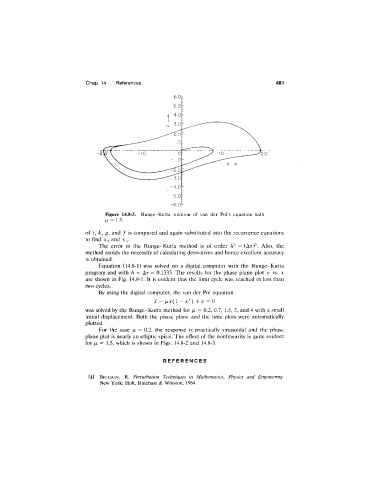Page 494 - Thomson, William Tyrrell-Theory of Vibration with Applications-Taylor _ Francis (2010)
P. 494
Chap. 14 References 481
Figure 14.8-3. Runge-Kutta solution of van der Pol’s equation with
fJL = 1.5.
of /, k, g, and / is computed and again substituted into the recurrence equations
to find X3 and
The error in the Runge-Kutta method is of order = (Ar)^. Also, the
method avoids the necessity of calculating derivatives and hence excellent accuracy
is obtained.
Equation (14.8-1) was solved on a digital computer with the Runge-Kutta
program and with h = At = 0.1333. The results for the phase plane plot y vs. x
are shown in Fig. 14.8-1. It is evident that the limit cycle was reached in less than
two cycles.
By using the digital computer, the van der Pol equation
X —jjix {I —x^) + x = 0
was solved by the Runge-Kutta method for ¡x = 0.2, 0.7, 1.5, 3, and 4 with a small
initial displacement. Both the phase plane and the time plots were automatically
plotted.
For the case /x = 0.2, the response is practically sinusoidal and the phase
plane plot is nearly an elliptic spiral. The effect of the nonlinearity is quite evident
for ¡JL = 1.5, which is shown in Figs. 14.8-2 and 14.8-3.
R E F E R E N C E S
[1] B e l l m a n , R. Perturbation Techniques in Mathematics^ Physics and Engineering.
New York: Holt, Rinehart & Winston, 1964.

